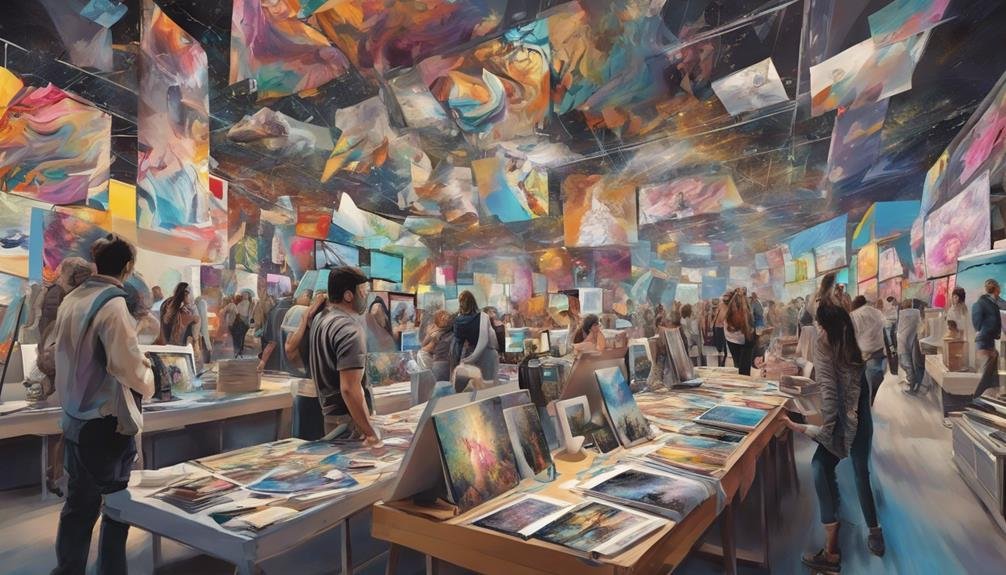The exponential rise in iconic digital art sales, such as Beeple’s ‘Everyday: The First 5000 Days’ for $69.3 million, signifies a monumental shift in valuing digital creations. This trend reshapes the art market. NFT technology revolutionizes art collecting by offering unique certificates and direct artist-to-buyer transactions.
Blockchain authentication guarantees transparency and security, challenging traditional art sales structures. High-profile NFT auctions set new benchmarks, attracting global interest and establishing a new era in the art world. Understanding the impact of these sales reveals a dynamic evolution in art acquisition and market dynamics, shaping the industry’s future.
Table of Contents
Brief Overview of Iconic Digital Art Sales and Their Impact
- Top NFT transactions redefine art market trends.
- Digital art gains recognition in traditional galleries.
- Direct artist-to-buyer transactions increase.
- NFT technology revolutionizes art collecting.
- Blockchain technology ensures authenticity and security in art sales.
Historical NFT Sales Overview
The historical overview of NFT sales reveals unprecedented transactions that have revolutionized the digital art market. Artists like Beeple, XCOPY, and Dmitri Cherniak have showcased the immense potential of NFTs by selling their digital artwork for millions of dollars in auctions. Beeple’s ‘Everydays: The First 5000 Days‘ set a groundbreaking record in the NFT space, selling for a staggering $69.3 million, making it the most expensive NFT sale.
XCOPY’s ‘Right-click and Save As Guy’ fetched $7 million, highlighting the increasing value collectors are willing to pay for unique digital art pieces. Similarly, Dmitri Cherniak’s ‘Ringers #109‘ sold for $7.1 million, reflecting the success and demand for NFT artworks. These notable sales signify a shift in the art world, where digital creations are being recognized, valued, and acquired at unprecedented prices, paving the way for a new era in artistic expression and ownership.
Impact on Digital Art Market

The impact of NFT sales on the digital art market is evident in the significant growth trends and increased recognition for artists. Market dynamics have shifted as traditional galleries incorporate NFT auctions, reflecting the growing influence of digital art in the art market landscape. This evolution has boosted artist visibility and challenged traditional art sales structures by enabling direct transactions between creators and collectors.
Market Growth Trends
Experiencing unprecedented growth, the digital art market’s trajectory has been dramatically influenced by the rapid expansion of the NFT sector. Beeple’s ‘Everydays: The First 5000 Days’ set a record at $69.3 million, showcasing the NFT market growth. Artists like XCOPY and Dmitri Cherniak have also achieved million-dollar NFT sales, underlining the sector’s success. CryptoPunks witnessed high-value sales, with #5822 fetching $23.7 million, reflecting the market’s upward trends.
Collaborations like Julian Assange and Pak’s ‘Clock‘ selling for $52.7 million have further fueled the market’s expansion. These instances signify the NFT market’s profound impact on the digital art world, reshaping notions of ownership and value while catapulting artists to new heights of recognition.
Artist Recognition Boost
Elevating digital artists to mainstream recognition, iconic NFT sales like Beeple’s ‘Everydays: The First 5000 Days’ for $69.3 million have profoundly impacted the digital art market. These high-value NFT sales at prestigious auction houses have provided artist recognition boosts and legitimized digital art as a valuable asset. Direct artist sales through NFTs have empowered artists to have more control over their work and profits, bypassing traditional intermediaries.
Additionally, global opportunities have emerged for artists to showcase their creations to a broader audience, breaking geographical barriers. The increased creativity and innovation witnessed in the digital art world after these iconic sales signify a shift in artistic norms and a push toward boundary-pushing creations.
Significance of Top NFT Transactions

Top NFT transactions hold immense significance in digital art, reflecting evolving market trends and offering artists unprecedented recognition opportunities. These high-value sales set new benchmarks for the industry and spotlight the growing interest in NFTs as a valuable asset class. Analyzing the top NFT transactions can provide helpful insights into the shifting landscape of digital art and the increasing prominence of blockchain technology in the art market.
NFT Market Trends
The recent surge in high-value NFT transactions, exemplified by notable sales like Beeple’s ‘Everydays: The First 5000 Days’ for $69.3 million, underscores the growing significance of NFT market trends. XCOPY’s NFT sales, such as ‘A Coin for the Ferryman‘ for $6.02 million and ‘Right-click and Save As Guy‘ for $7 million, along with Ross Ulbricht’s ‘FreeRoss’ NFT selling for $6.12 million, demonstrate the prevalence of high-value transactions in the digital art market.
Dmitri Cherniak’s NFT sales of ‘Ringers #879’ for $6.2 million and ‘Ringers #109’ for $7.1 million further contribute to the evolving landscape of the NFT art market. Additionally, the substantial prices fetched by CryptoPunk NFTs, like #5822 for $23.7 million and #7523 for $11.7 million, highlight these digital collectibles’ enduring popularity and value.
Artist Recognition Opportunities
In digital art sales, the significance of top NFT transactions extends beyond monetary value to offer artists unparalleled recognition opportunities.
- Beeple’s record-breaking sale of ‘Everydays: The First 5000 Days’ for $69.3 million at Christie’s solidified his position as one of the most valuable living artists.
- XCOPY’s ‘Right-click and Save As Guy’ NFT fetching $7 million highlighted the high demand for digital art by contemporary artists.
- Ross Ulbricht’s ‘FreeRoss’ NFT sale for $6.12 million showcased the potential of NFTs to support causes and individuals.
- Dmitri Cherniak’s ‘Ringers #109’ NFT sale for $7.1 million emphasized the market’s interest in unique digital art projects, further fueling artist recognition opportunities within the NFT market.
Evolution of Art Collecting

With the advent of NFT technology, art collecting has undergone a transformative evolution, reshaping traditional practices and opening new avenues for artists and collectors. The rise of NFTs has revolutionized art collecting by enabling ownership of digital artworks through unique digital certificates. This innovation has allowed direct sales between artists and collectors, eliminating the need for traditional intermediaries in the art market.
Digital art sales, exemplified by Beeple’s staggering $69.3 million NFT transaction, have challenged the conventional art world and redefined how art is bought and sold. NFT technology has democratized art collecting, making it accessible to a global audience through blockchain verification. Consequently, the popularity of NFTs has created a significant shift in art collecting dynamics, with traditional art facing challenges as digital art sales reach record-breaking prices.
This evolution highlights the changing landscape of the art market, with digital art increasingly gaining prominence and pushing the boundaries of what defines valuable artwork.
NFTs Redefining Ownership in Art

Undermining traditional ownership structures in art, NFTs have emerged as a pioneering force in redefining the concept of possessing digital artworks.
- NFTs revolutionize art ownership by providing unique digital certificates on the blockchain, ensuring the authenticity and provenance of digital artworks.
- These digital certificates eliminate the need for intermediaries in art transactions, enabling direct sales between artists and collectors.
- NFTs also feature built-in royalty systems in the secondary market, allowing creators to benefit from ongoing profits as their artworks are resold.
- The surge in NFT sales by celebrities and prestigious auction houses has significantly boosted the contemporary art market, attracting a new wave of collectors and investors into the digital art space.
Blockchain Technology in Art Sales

Utilizing blockchain technology has fundamentally transformed art sales by introducing non-fungible tokens (NFTs) that authenticate ownership of digital artworks. These NFTs, recorded on the blockchain, guarantee digital art’s authenticity and transparent provenance, making it tamper-proof and secure. The decentralized nature of blockchain technology allows for direct artist-to-buyer transactions, revolutionizing the art market by eliminating the need for intermediaries.
By leveraging blockchain, NFTs provide a democratized market for artists, offering a global platform to showcase and sell their work. This innovation has created a more transparent and efficient system for buying and selling digital artworks, establishing a new era in the art world. The adoption of blockchain technology in art sales not only enhances the security and trust in transactions but also opens up new possibilities for artists to reach a broader audience and gain recognition on a global scale.
High-Profile NFT Auctions

The surge in high-profile NFT auctions has captured global attention, showcasing the current market’s exceptional value and demand for digital artworks. These auctions have demonstrated the potential for immense profits within the NFT ecosystem and highlighted the growing influence of digital artists in the art world. Here are some remarkable examples:
- Beeple’s ‘Everydays: The First 5000 Days’ sold for $69.3 million at a Christie’s auction, setting a new standard for record-breaking sales.
- XCOPY’s ‘Right-click and Save As Guy’ fetched $7 million in December 2021, underscoring the artist’s prominence in high-profile NFT auctions.
- Ross Ulbricht’s ‘FreeRoss’ was sold for $6.12 million, signifying a significant milestone in the NFT market success for this digital artist.
- CryptoPunk #5822 became the most expensive CryptoPunk ever sold, commanding $23.7 million and emphasizing the high value placed on iconic digital art in today’s market.
Art World Paradigm Shift

Amidst a rapidly evolving artistic landscape, the art world is undergoing a profound paradigm shift towards embracing digital mediums and innovative technologies. Iconic digital art sales, such as Beeple’s ‘Everydays: The First 5000 Days’ for $69.3 million, have revolutionized the art world by highlighting the value of NFTs. NFT sales by artists like XCOPY and Ross Ulbricht further solidify this shift toward digital art ownership and trading.
Notable sales like Julian Assange and Pak’s ‘Clock’ for $52.7 million showcase the significant impact of digital art on traditional art markets. High-value transactions involving CryptoPunks, like the sale of #5822 for $23.7 million, demonstrate digital collectibles’ increasing importance and value within the art industry. Collaborations between artists and traditional auction houses, such as Christie’s, signify a new art acquisition and investment era through NFTs.
This shift marks a significant departure from conventional art market practices. It opens up new avenues for artists and collectors alike.
Future Implications of NFT Sales

In the evolving art market, the increasing prevalence of NFT sales is poised to reshape the landscape of art acquisition and ownership.
- NFT sales are expected to revolutionize the art market, becoming the standard method for buying and selling art.
- While traditional artists may not quickly shift to the digital domain, established digital artists will likely continue thriving in the NFT space.
- NFTs are viewed as a catalyst for ushering in a new generation of artists and collectors, bringing about significant changes in the evolving art market.
- Auction houses like Christie’s are gearing up to collaborate with more digital artists, aiming to auction NFTs and promote the NFT space thoughtfully, aiming to shape the future impact of NFT sales on the art industry responsibly and creatively.
Frequently Asked Questions
How Has Digital Art Impacted Art?
Digital art has profoundly impacted the art market by enhancing creative expression, leveraging technological evolution, empowering artists, and fostering global accessibility. It has reshaped the traditional art landscape, sparking innovation and copyright challenges while engaging audiences with its cultural significance.
What Is the Highest NFT Sales of All Time?
Among the highest NFT sales of all time are Beeple’s ‘Everydays: The First 5000 Days’ at $69.3 million and Julian Assange and Pak’s ‘Clock’ at $52.7 million. These record-breaking sales underscore the growing significance of the NFT market.
What Digital Art Is Most Popular?
“Creativity knows no bounds in the world of digital art. From surreal landscapes to urban street art, pop culture influences to futuristic concepts, various styles capture the hearts of art enthusiasts worldwide.”
The popularity of digital art can vary depending on trends, styles, and individual preferences. However, some popular types of digital art include:
- Digital painting: Creating artworks using digital tools that simulate traditional painting techniques.
- Vector art: Using vector graphics to create images that can be scaled without losing quality.
- Pixel art: Creating images using pixel-by-pixel editing, often with a retro video game aesthetic.
- 3D modelling: Creating three-dimensional objects and environments using software tools.
- Photo manipulation: Editing and enhancing photographs using digital software.
- Character design: Creating original characters and illustrations using digital tools.
- Concept art: Creating visual designs for characters, environments, and objects in various media such as games, films, and animation.
These are just a few examples of popular digital art forms, and the popularity can fluctuate based on current trends and individual preferences within the art community.
How Much Is First 5000 Days Worth Now?
The current value of Beeple’s ‘Everydays: The First 5000 Days’ NFT, after its record-breaking $69.3 million sale, remains undisclosed. Future projections are uncertain, subject to market trends, collector interest, and Beeple’s established reputation. Technological advancements, investment potential, authenticity concerns, cultural significance, and resale opportunities are vital considerations.
Conclusion
To sum up, the rise of NFT sales in digital art has sparked a paradigm shift in the art world, redefining ownership and revolutionizing art collecting. With high-profile transactions and the integration of blockchain technology, the impact of these sales on the market is undeniable.
As NFTs continue to shape the future of art sales, the implications for artists, collectors, and the industry are vast and far-reaching.




